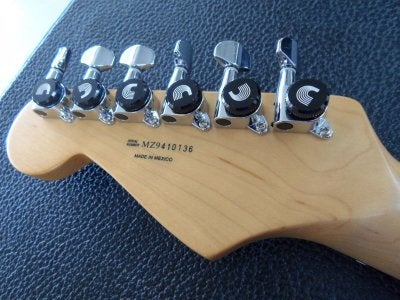

These 1965-1976 era guitars are commonly referred to as the F series because of the neck plate design change. CBS continued the sequence Fender started in 1954. CBS came up with a new numbering system to take advantage of the fact that Leo did not use 6-digit ID numbers. The indentification number sequences were no exception. A lot of changes happened to the company as well as the guitars themselves under the new ownership. In early 1965, Leo Fender sold Fender Musical Instruments, Inc. Some guitars in these years have them and some don’t. For some reason during 1955, 1957, and 1958 Fender decided to place zero or a dash in front of ID numbers periodically. As you can see, there is quite a bit of overlap. The low and high columns show the range of indentification numbers that have been positively matched to specific years. The number column represents the general number grouping that Fender and most experts agree on. This list is a little convoluted because there are so many over lapping serial numbers. The only way to verify an over lapping date is to check the corresponding neck date and body date. You may notice that there is a great deal of over lapping numbers in these nine years. Some of these indentification numbers are still out of sequence, jumbled up, or missing.
Fender serial number lookup dn serial numbers#
He started using one sequence of serial numbers for all the guitars coming off of the Fender production lines including Teles, Esquires, Strats, and P-basses.

They were simply internal numbers to help with production.Īt some point in 1954, Fender decided to stop grouping the guitar ID number by model. Remember, these serial and neck numbers were never really intended for historical dating. Being many months later, the serial number date and the neck date might not match. After the entire guitar was assembled, the indentification number was stamped in place. Necks could sit for days, weeks, or even months at a time before being matched with a body. The number and date on the neck is simply the date that the neck was finished–not the date that the guitar was completed. That’s how the Fender production line worked. He wired the pickguard with pickups, so all the wiring could be finished before the body was even dry from finishing. He made a bolt-on neck, so the neck and the body could be manufactured at the same time. Unlike Gibson, Leo found did everything the cheapest and fastest way possible. Leo Fender was a genius with minimizing the costs of production. Why is this? It all has to do with how Fender produced guitars. After reviewing the ID number, you might find out that the two corresponding dates don’t coincide. Many people think that the date on the heel of their Fender neck is the production date of the guitar. Fender only decided to write dates on the bodies for a few years here and there. Few Fender guitars have dates written on the bodies under the pickups, in the routed out cavities, and near the wiring harnesses.

Some Fender guitar bodies and pickups also have dates written on them. Almost all Fender guitars have a dated neck. This marking is only visible when the neck is removed from the body because it is covered in the neck pocket. After the neck was finished, a Fender employee would either stamp or handwrite the date on the end of the guitar neck on its heel. Fender also dated the neck when it was manufactured. The serial numbers on the outside of the body are not the only way to date a Fender guitar however. True to form the reissue guitars have their indentification numbers stamped in the neck plate. These guitars were replicas of the early 19s era guitars. In 1982 Fender decided to start making reissued vintage guitars. Modern Fender production guitars, 1976 to the present, have their ID numbers on the front or back of the headstock near the Fender decal. From 1954 to 1976 Fender stamped its guitar’s serial number on either the top or bottom of the neck plate. From 1950 to 1954 Fender guitar unique numbers were stamped in the bridge cavity cover plate. The serial number location has changed a few times of the years. In order to tell how old your Fender is you will have to find the indentification number or neck number. This article is intended to help you date your Fender Stratocaster, Telecaster, and Precision Bass guitars all the way back to the early 1950s.


 0 kommentar(er)
0 kommentar(er)
